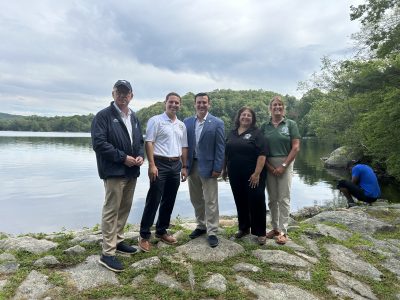Lawmakers Call for State Funding to Help Keep Lakes Healthy
News Based on facts, either observed and verified directly by the reporter, or reported and verified from knowledgeable sources.

With many beaches in the Hudson Valley forced to close last week due to harmful pollution, several state and local officials are lobbying for funding to be allocated to curb the recurring problem.
During a press conference at a healthy Roaring Brook Lake in Putnam Valley last Friday, Assemblyman Matt Slater (R-Yorktown), state Sen. Rob Rolison (R-Poughkeepsie), Putnam County Executive Kevin Byrne and Putnam Valley Supervisor Jackie Annabi called for the state to invest in new technology and infrastructure to help combat harmful algal blooms (HABs).
The HABs, made worse by the recent onslaught of hot and humid weather, led to five beaches in Putnam and two beaches on Mohegan Lake in Yorktown being declared off limits to swimmers and boaters. There are other waterbodies in Westchester and a few in Rockland that were also closed to the public as well.
“Residents and visitors are being denied the ability to enjoy some of our great natural assets this summer because of these beach closures, and the state cannot keep burying its head in the sand,” Slater said. “Every year, our communities are combating harmful algal blooms, and the problem is now reaching every corner of the state. This is a complex issue that requires greater investment and a more comprehensive approach from New York State.”
Legislation proposed by Slater and Rolison would add HABs within the definition of water contaminant and require the implementation of measures aimed at efficiently managing and mitigating the adverse effects of HABs in marine and freshwater environments.
In addition, it would require the development of emergency protocols to swiftly address instances of HABs and establishes a commission to develop regional monitoring and response plans.
The proposal would also direct Cornell University to complete a study of HABs and provide the findings to the governor, state legislature, various state agencies and the HABs Commission. The state’s Environmental Facilities Corporation would be authorized to provide funding for emergency drinking water supplies when contamination has resulted in HABs or hypoxia, where there are low levels of oxygen.
“It’s not a lack of money. It’s getting money to municipalities and private landowners,” Rolison said. “It is happening more often. There is a new normal, so the state needs to get away from the other normal. We need to see how we can streamline the process.”
Slater pointed to the $4 billion voter-approved Environmental Bond Act as one funding source the state could tap into to invest in new technology, such as ultrasound devices, aeration systems and septic remediation programs.
“Public health and safety should be a priority for every level of government,” Byrne added. “Harmful algal blooms are a public health issue. They are affecting communities across the state and Putnam County is not immune.”
In 2018, Gov. Andrew Cuomo announced action plans to combat harmful algal blooms. Three of the 12 waterbodies mentioned were in Putnam County. Slater noted while the action plans were productive in identifying ways to reduce pollution sources, the lack of adequate funding prevented the plans’ full implementation.
“We’re not saying the DEC (state Department of Environmental Conservation) is not doing their job. They’re monitoring the situation,” Slater said. “The system is not working well enough to tackle this head-on. We’re just trying to be more urgent on the matter.”
HABs can be different colors. They may be green, blue-green, yellow, brown or red. They may have a scum on the water surface or at the shoreline. Large blooms often look unnatural, like paint has been spilled into the water.
Putnam County Health Department Sanitarian Vincent Perrin said HABs can cause health effects in people and animals and cautioned pet owners to keep dogs out of closed beaches. A person can be infected when a person’s skin touches the algae bloom or when water is swallowed or droplets are inhaled. The blooms can also be a major hazard to drinking water supplies.
Perrin noted the Health Department takes water samples of lakes every two weeks.
“It’s all across New York State,” Perrin said. “Almost every lake has experienced some closure.”

Rick has more than 40 years’ experience covering local news in Westchester and Putnam counties, running the gamut from politics and crime to sports and human interest. He has been an editor at Examiner Media since 2012. Read more from Rick’s editor-author bio here. Read Rick’s work here: https://www.theexaminernews.com/author/pezzullo_rick-writer/
